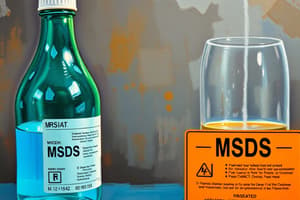Podcast
Questions and Answers
Which of the following should you do when handling chemicals?
Which of the following should you do when handling chemicals?
- Use care in handling contaminated glassware (correct)
- Store chemicals in unlabeled containers
- Leave chemicals unattended
- Eat snacks while working
It is safe to smoke near chemicals in the lab.
It is safe to smoke near chemicals in the lab.
False (B)
What should you do if you cannot extinguish a chemical fire?
What should you do if you cannot extinguish a chemical fire?
- Look for more flammable materials
- Try to extinguish the flames
- Notify the chemical supplier
- Evacuate the area immediately (correct)
What should you do with chemicals that are no longer needed?
What should you do with chemicals that are no longer needed?
It is safe to pour chemical waste down the drain if done quickly.
It is safe to pour chemical waste down the drain if done quickly.
You should always wear appropriate __________ when working with chemicals.
You should always wear appropriate __________ when working with chemicals.
What does PPE stand for?
What does PPE stand for?
Match the safety action with its corresponding guideline:
Match the safety action with its corresponding guideline:
When encountering a hazardous waste, always use a __________ container with a label.
When encountering a hazardous waste, always use a __________ container with a label.
Match the following actions to their appropriate chemical safety procedures:
Match the following actions to their appropriate chemical safety procedures:
What was Wetterhahn's blood mercury level compared to the toxic threshold?
What was Wetterhahn's blood mercury level compared to the toxic threshold?
Proper storage and handling of chemicals can eliminate all associated risks.
Proper storage and handling of chemicals can eliminate all associated risks.
At what age did Wetterhahn die?
At what age did Wetterhahn die?
Routine inspections of chemical storage areas should be conducted at least _____ annually.
Routine inspections of chemical storage areas should be conducted at least _____ annually.
Match the following hazards with their corresponding storage considerations:
Match the following hazards with their corresponding storage considerations:
Which action is recommended when chemicals are expired or unwanted?
Which action is recommended when chemicals are expired or unwanted?
In an emergency spill response, one should always respond to a major spill regardless of their training level.
In an emergency spill response, one should always respond to a major spill regardless of their training level.
What should be done to incompatible materials in chemical storage?
What should be done to incompatible materials in chemical storage?
What is the primary focus of the term 'hazard' in safety terms?
What is the primary focus of the term 'hazard' in safety terms?
Chronic exposure refers to short-term exposure to harmful substances.
Chronic exposure refers to short-term exposure to harmful substances.
Name one route of chemical exposure.
Name one route of chemical exposure.
To minimize exposure to hazards, individuals should wear __________.
To minimize exposure to hazards, individuals should wear __________.
Match the protection measures to their correct descriptions:
Match the protection measures to their correct descriptions:
Which of the following is classified as acute exposure?
Which of the following is classified as acute exposure?
Less toxic chemicals are never hazardous when handled improperly.
Less toxic chemicals are never hazardous when handled improperly.
What tragic event highlighted the importance of following safety protocols in the lab?
What tragic event highlighted the importance of following safety protocols in the lab?
What chemical was R.A. working with when the incident occurred?
What chemical was R.A. working with when the incident occurred?
R.A. was wearing a lab coat at the time of the incident.
R.A. was wearing a lab coat at the time of the incident.
What percentage of R.A.'s body was burnt in the fire?
What percentage of R.A.'s body was burnt in the fire?
Dimethylmercury can rapidly permeate latex gloves and enter the skin within _____ seconds.
Dimethylmercury can rapidly permeate latex gloves and enter the skin within _____ seconds.
Which material is NOT recommended for protection against strong acids?
Which material is NOT recommended for protection against strong acids?
Match the glove material with its compatibility:
Match the glove material with its compatibility:
What was the primary focus of Karen Wetterhahn's research?
What was the primary focus of Karen Wetterhahn's research?
The fire that occurred with R.A. was caused by introducing air into a syringe.
The fire that occurred with R.A. was caused by introducing air into a syringe.
What is the flash point of petroleum ether?
What is the flash point of petroleum ether?
The Globally Harmonized System (GHS) of chemical labeling is a binding system that all countries must follow.
The Globally Harmonized System (GHS) of chemical labeling is a binding system that all countries must follow.
What document is prepared by the chemical manufacturer that describes hazards and safe handling procedures?
What document is prepared by the chemical manufacturer that describes hazards and safe handling procedures?
A proper chemical spill response should include _____ and appropriate waste disposal.
A proper chemical spill response should include _____ and appropriate waste disposal.
Match the following safety concepts with their descriptions:
Match the following safety concepts with their descriptions:
Which of the following is NOT included in a Material Safety Data Sheet (MSDS)?
Which of the following is NOT included in a Material Safety Data Sheet (MSDS)?
Personal Protective Equipment (PPE) is not necessary for handling chemicals.
Personal Protective Equipment (PPE) is not necessary for handling chemicals.
Name one method by which hazards are communicated to workers.
Name one method by which hazards are communicated to workers.
The ability of a chemical to cause harm is referred to as _____ .
The ability of a chemical to cause harm is referred to as _____ .
What resulted from the ignition of petroleum ether in the freezer scenario?
What resulted from the ignition of petroleum ether in the freezer scenario?
Flashcards
Risk in Safety
Risk in Safety
The potential for a material to cause harm under specific conditions of use.
Chemical Exposure Routes
Chemical Exposure Routes
The ways a hazardous material can enter the body.
Acute Exposure
Acute Exposure
Short-term effects of hazardous material exposure.
Chronic Exposure
Chronic Exposure
Signup and view all the flashcards
Hierarchy of Risk Controls
Hierarchy of Risk Controls
Signup and view all the flashcards
Personal Protective Equipment (PPE)
Personal Protective Equipment (PPE)
Signup and view all the flashcards
The Sheharbano ‘Sheri’ Sangji Case
The Sheharbano ‘Sheri’ Sangji Case
Signup and view all the flashcards
Sheharbano ‘Sheri’ Sangji
Sheharbano ‘Sheri’ Sangji
Signup and view all the flashcards
MSDS (Material Safety Data Sheet)
MSDS (Material Safety Data Sheet)
Signup and view all the flashcards
Containing a chemical spill
Containing a chemical spill
Signup and view all the flashcards
Proper PPE (Personal Protective Equipment)
Proper PPE (Personal Protective Equipment)
Signup and view all the flashcards
Evacuate area
Evacuate area
Signup and view all the flashcards
Hazardous Waste Disposal
Hazardous Waste Disposal
Signup and view all the flashcards
Store chemicals in their original containers
Store chemicals in their original containers
Signup and view all the flashcards
Wear appropriate safety gear and work in a controlled environment
Wear appropriate safety gear and work in a controlled environment
Signup and view all the flashcards
Dispose chemicals properly
Dispose chemicals properly
Signup and view all the flashcards
Never use unlabeled containers
Never use unlabeled containers
Signup and view all the flashcards
Never mouth pipette
Never mouth pipette
Signup and view all the flashcards
Safe Chemical Handling
Safe Chemical Handling
Signup and view all the flashcards
Chemical Storage Inspections
Chemical Storage Inspections
Signup and view all the flashcards
Inventory control
Inventory control
Signup and view all the flashcards
Segregation of chemicals
Segregation of chemicals
Signup and view all the flashcards
Chemical Storage Guide
Chemical Storage Guide
Signup and view all the flashcards
Chemical Spill Response
Chemical Spill Response
Signup and view all the flashcards
Chemical Spill Response: Stop. Think. IS IT A MAJOR SPILL?
Chemical Spill Response: Stop. Think. IS IT A MAJOR SPILL?
Signup and view all the flashcards
Wetterhahn's Mercury Levels
Wetterhahn's Mercury Levels
Signup and view all the flashcards
Nitrile Gloves
Nitrile Gloves
Signup and view all the flashcards
t-Butyl Lithium
t-Butyl Lithium
Signup and view all the flashcards
Dimethylmercury (DMM)
Dimethylmercury (DMM)
Signup and view all the flashcards
Latex Gloves
Latex Gloves
Signup and view all the flashcards
Flash Fire
Flash Fire
Signup and view all the flashcards
Permeability
Permeability
Signup and view all the flashcards
Glove Material
Glove Material
Signup and view all the flashcards
Lab Safety
Lab Safety
Signup and view all the flashcards
Material Safety Data Sheet (MSDS)
Material Safety Data Sheet (MSDS)
Signup and view all the flashcards
Toxicity
Toxicity
Signup and view all the flashcards
Globally Harmonized System (GHS)
Globally Harmonized System (GHS)
Signup and view all the flashcards
Hazard Communication
Hazard Communication
Signup and view all the flashcards
Flash Point
Flash Point
Signup and view all the flashcards
Chemical Storage
Chemical Storage
Signup and view all the flashcards
Waste Disposal
Waste Disposal
Signup and view all the flashcards
General Safety Rules
General Safety Rules
Signup and view all the flashcards
Study Notes
Chemical Safety Overview
- Chemical safety is crucial for handling and using chemicals safely.
- A case study involved petroleum ether (PE) stored in a freezer, which leaked and ignited, causing significant damage.
- Another case involved hydrogen buildup in an anaerobic hood, leading to an explosion.
- Four workers were affected in this second case, one critically.
- Personnel ignored warning systems.
Hazard Communication
- Allows workers to understand the hazards and identities of the chemicals they are exposed to.
- Describes the protection measures workers can use to protect themselves
- HazComm is communicated through labels and Material Safety Data Sheets (MSDS).
- Education and training are complementary components of HazComm.
Material Safety Data Sheet (MSDS)
- A document prepared by chemical manufacturers describing chemical properties.
- It details physical and health hazards and exposure routes.
- Guidance for safe handling and use and emergency/first-aid procedures.
- Control measures are also detailed within this safety document.
Globally Harmonized System (GHS)
- A "non-binding" system adopted globally for hazard communication.
- Defines and classifies chemical hazards, creating standardized labels and safety data sheets (SDSs).
- Provides safe and consistent methods of communication across jurisdictions.
- GHS includes pictograms to represent varied hazards.
Toxicity and Risk
- Toxicity is a chemical's ability to cause harm. Risk is how likely a material is to cause harm in use conditions.
- Proper handling can ensure the safe use of highly toxic chemicals.
- Improper handling can lead to hazards even with less toxic chemicals.
Chemical Exposure
- Four routes for chemical exposure include inhalation, ingestion, injection, and absorption.
- Classification of exposure is based on duration, distinguishing acute (short-term) and chronic (long-term) exposures; this determines short vs. long-term effects.
- Acute exposure symptoms include eye irritation, nausea, dizziness, skin rash, burns, and headache.
Protection Measures
- The hierarchy of risk controls emphasizes hazard elimination, substitution, engineering controls, administrative controls, and personal protective equipment (PPE).
- Engineering controls such as fume hoods, engineered sharps, and eye washes greatly reduce exposure risk.
- Administrative controls like education, training, procedures, and scheduling minimize risks through improved awareness of potential hazards.
Personal Protective Equipment (PPE)
- PPE is worn to minimize hazards, injuries, and illnesses resulting from exposure to chemicals, radiation, physical, electrical, and mechanical hazards.
- Approprite PPE includes, but is not limited to, gloves (correct size and material), lab coats, eye protection, safety shoes, respirators, and face shields.
Chemical Storage
- Proper procedures for chemical handling involve routine inspections and maintaining stringent inventory control.
- Minimizing the quantity of chemicals on hand, including the prompt removal of expired chemicals, reduces overall hazard.
- Storage areas must be inspected at least annually to ensure correct conditions for storing chemicals.
- Segregation (physical barriers and distance) is necessary to prevent incompatible materials from interaction.
Chemical Spill Response
- Do not respond beyond your training level.
- Proper safety measures depend on whether it's a large or small spill.
- Small spills involve removing contaminated clothing, using appropriate personal protective equipment (PPE).
- Contain the spill, notifying workers. Seek advice from material safety data sheets (MSDS) and inform your supervisor/security.
- Large spills require evacuation; notify authorities and use the appropriate safety procedures.
Chemical Fire
- Stop, think, and only try to extinguish the fire if you are trained to do so, otherwise evacuate the area.
- If safe, extinguish open flames, turn off gas or electricity as soon as possible.
- Notify workers, ventilate and inform supervisor/security.
Hazardous Waste
- Minimize waste generation and dispose of hazardous waste properly using appropriate containers.
- Know your chemical classification.
- Use flame-resistant containers with labels.
- Dispose of broken thermometers using proper mercury disposal techniques.
General Safety Rules
- Store chemicals in their original containers.
- Wear appropriate safety gear in a controlled environment.
- Properly dispose of chemicals.
- Be cautious when handling contaminated glassware.
- Familiarize yourself with chemical properties and toxicity.
- Avoid eating, drinking, or applying cosmetics near chemicals. Avoid mouth pipetting.
Lab Safety Rules
- Dress appropriately (safety gear).
- Be careful when handling hot glassware (turn off heating appliances immediately).
- Know locations for emergency numbers and safety equipment.
- Keep the area clean and free of obstructions.
- Handle glassware carefully.
- Report cuts, spills, and broken glass immediately.
- Avoid using food or drinks. No food in the lab.
Studying That Suits You
Use AI to generate personalized quizzes and flashcards to suit your learning preferences.




